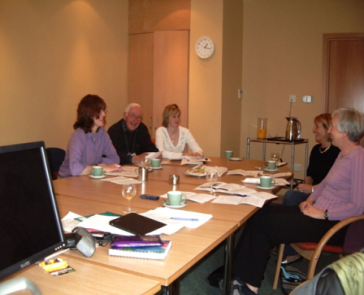PPI 2015 Unit II
| Site: | University of Edinburgh Moodle |
| Course: | Patient and Public Involvement [2015-2016] [SEM 2] |
| Book: | PPI 2015 Unit II |
| Printed by: | Guest user |
| Date: | Friday, 26 December 2025, 2:49 PM |
Description
PPI 2015 Unit II
1. Introduction
Unit II Patient and public involvement in practice 
In this unit, we will move from theory to putting patient and public involvement into practice. We will explore the different ways of involving patients and members of the public in research, how to find people to involve and how to make involvement meaningful. We will look at the barriers to effective patient and public involvement and how these might be overcome. We will also look at the patient perspective: why do patients want to get involved and what do they expect from involvement? You will have the opportunity to discuss one patient’s experience of involvement in an online discussion with Olivia Fulton (Wednesday, February 3rd), who is involved in asthma research. An important aspect of your learning throughout this unit is to reflect on how all this can be applied to your own practice and to the conduct of clinical trials in general.
Aims
The aim of Unit II is to develop a sound understanding of how to introduce, develop and sustain effective patient and public involvement in research.
Learning outcomes
- Critically appraise the theory and key principles of patient and public involvement in clinical research
- Critically assess their own practice/place of work in relation to the level of patient and public involvement in research.
- Evaluate the barriers to effective patient involvement and strategies and techniques to overcome such barriers.
- Design a patient and public involvement strategy for a clinical trial
2. Overview
Features
Unit II runs over two weeks (Jan 25th - Feb 7th) and is organised into the following 3 lessons:
- Lesson 1 Putting patient and public involvement into practice
- Lesson 2 Barriers and facilitators to effective patient and public involvement in research
- Lesson 3 The Patient Perspective
Each lesson is comprised of a selection of partner readings, written content and independent activities. There is a Unit II discussion board which includes 2 Thought questions for collaborative discourse.
As you may know from the course planner, there are a number of key dates and action points for you to be aware of in weeks 3 & 4:
Key dates
- Friday, Feb 5th: Due date Reflective diary to Allison Worth for interim feedback (optional but recommended)
Adobe Connect
- Thursday, Jan 28th (6 - 7 pm): Adobe connect tutorial with Allison Worth
- Topic: Your views of patient and public involvement
- Wednesday, Feb 3rd (6 - 7 pm): Online expert guest lecture with Olivia Fulton
- Topic: The patient perspective on being involved
Adobe Connect URL: http://edinburghcrf.adobeconnect.com/ppi/
Your tasks
Please refer to the Unit II checklist
[Checklist pops up in a separate window]
3. Core readings & resources
For core readings and resources, please refer to the Resource list on the Moodle course homepage (from the menu list on the left-hand side of the page).
4. Lesson 1 Putting into practice
Partner readings
For Unit II partner readings, please refer to the Resource list on the Moodle course homepage (from the menu list on the left-hand side of the page).
Topics
- Ways of involving people in research
- Lay and professional expertise
- Finding people to involve
Introduction
In this lesson, you will learn about the many ways patients and the public can be involved in research. We'll look at the nature of patient and public expertise and what it brings to the research team. We'll look at a very practical issue - how do researchers find appropriate people to involve? And we'll consider to what extent should we worry about representativeness?
4.1. Ways of involving people in research
Your reading will have helped you to understand the variety of ways of involving patients and the public in the design and conduct of a clinical trial or research programme.
These might include:
- Consulting patients about research topics/questions
- Contributing to proposal writing and being co-applicants on grants
- Involving people in project steering group or Trial Steering Committee
- Having a Patient Advisory Group of three or more people for a study
- Specific tasks such as reviewing the lay summary of a grant application or report
- Commenting on patient information sheets
- Participating in systematic reviews
- Interviewing participants, focus group facilitation
- Contributing to data analysis/interpretation
- Facilitating workshops on the impact of research
- Helping to write reports, lay summaries, presentations
- Conference presentations and publications
- Website content and design
- Appointing a patient panel to review PhD applications
- Sitting on interview panels for researchers
- Contributing to staff training
Probably the most common way of involving people is appointing one or more patients to a project steering group or Trial Steering Committee. It is most likely the commonest way because it seems to require little effort from the researchers, but if it is to be effective, considerable care and attention are needed. Any costs must be built into the grant application.
Stop & think
After the lecture and with the help of the Lesson 1 partner readings complete the Stop & think questions below.
|
Stop & think Q1. What are the advantages of appointing a patient or member of the public to a trial steering committee? Q2. What challenges are associated with appointing a patient or member of the public to a trial steering committee? |
4.2. Your turn: Thought question 1
Task I. Thought discussion
Please join us on the Unit II Thought discussion for Thought question 1.
In the context of a patient and public involvement in a clinical trial, it seems there may be tensions between lay and medical constructs of illness/healthcare and lay and technical knowledge of the research process. How might these tensions affect a trial steering committee and how can the tensions be managed?
Does patient expertise challenge professional expertise? Is this helpful or unhelpful?
We look forward to your thoughts!
5. Lesson 1b How to find people to involve
Researchers often struggle to know how to begin and where to find people to involve in their research. The first step is to consider who to involve. Do they need to be patients with a particular condition, people of a particular age, or will a generic lay perspective suffice? The answer will influence how you find people to involve. Finding people with a common illness such as asthma or diabetes is relatively easy compared with finding people with a rare condition because the pool of people is larger and there are more voluntary sector organisations which can be approached to identify people.
Contacting lay people without a specific health condition requires a different set of contacts, such as community groups, and may require some advertising.
A clear, concise role description in lay language is advisable, making the time commitment clear, so people will know what to expect.
There are more strategies for finding people to involve in the guide for researchers you read for Unit 1 Lesson 1.
6. Lesson 1c The thorny question of "representativeness"
A commonly-expressed concern by researchers is whether patients who get involved are ‘representative’. The question concerns whether a patient or small group of patients can represent the views of a larger group of people rather than just their own views or the views of a particular section of society (usually white, middle class, older people). But is the concern reasonable? If you consider the range of people with diabetes, for example, asking a small number of patients to represent the diverse views and experiences of all patients with diabetes is unrealistic. And does anyone ask the clinician if their views are representative of all clinicians? The aim of involving patients is to seek patient perspectives; including more patients provides a greater variety of perspectives. If people with specific characteristics are needed, such as those from a particular ethnic group, they will need to be sought out.
|
|
Stop & think Q1. How would you find people with diabetes to involve in a research study? (Remember – this is not about recruiting participants!) See http://www.invo.org.uk/posttyperesource/how-to-find-people-to-involve/ for some ideas. |
7. Lesson 2 Barriers and facilitators
Partner readings
For partner readings, please refer to the Resource list on the Moodle course homepage (from the menu list on the left-hand side of the page).
Topics
- What factors make patient and public involvement difficult?
- What can be done to overcome the difficulties?
Introduction
No one ever said that involving patients and the public in research is easy! Barriers exist among patients/the public and researchers. Involving patients requires systems to change as well. In this lesson, we'll look at the barriers and how they can be overcome.
7.1. Barriers to effective involvement
- Most people don’t know that opportunities for involvement in research exist.
- Unequal power relationships: patients who get involved lack confidence to speak.
- Lack of awareness and understanding among researchers of the need for and value of patient and public involvement.
- Unsupportive and overtly hostile team members.
- Lack of resources to support involvement, including researcher time and an adequate budget.
- Tokenistic involvement.
- Meetings held in working hours may exclude patients who work or have caring responsibilities.
- Poor communication about the research and lack of time given to help patients to understand their role or research methods and terminology.
- Patients who have difficulty widening their perspective from their own individual experience to the bigger picture.
- Patients who have a particular issue they can’t let go of – often related to a poor experience of healthcare.
7.2. Overcoming the barriers: how to make involvement meaningful
If involvement is not done well, it can be damaging, particularly to the patients involved. There is a danger that involvement which is not inherently valued and has not been adequately thought through will be tokenistic. This means it cannot add value to the research, as patients’ voices will not be heard and their views not acted on. So how can patient and public involvement be made meaningful? Here are some ideas; you might have more to add:
- Good communication helps to overcome most barriers
- The best way is to involve people before a grant application goes in, so they have a chance to influence the research from the start. If a researcher can demonstrate active involvement of patients and the public in the design of a study, it is much more impressive to grant funders than promises of what might be done further down the line.
- Adequate costs for patient involvement and public engagement should be allocated in the project budget.
- The purpose and process of involving patients/the public should be thought through, discussed with the team and documented in lay language so everyone is clear about roles and expectations. If there are sceptical team members, it is important to ensure that they respect the patient/public members of the team.
- Using virtual methods, such as email and Skype, can supplement face-to-face meetings, enabling more inclusive working practice
- Training for researchers and patients can be arranged. Mentoring and support for patients/members of the public who get involved is essential and it is advisable to make this someone’s particular responsibility within the team.
- One team member should act as facilitator and mentor, briefing the patient/public team members before meetings, debriefing after meetings and regularly checking their well-being to help them to manage their role.
- Evaluate the process from the perspectives of the patient/s and researchers to identify what works well, what might be done better and the impact of the involvement – and publish the evaluation.
As for letting members of the public know that opportunities to get involved in research exist, that is mainly a question of public engagement, which we will discuss later in the course.
|
|
Stop & think Q1. If the method of involvement is to appoint a patient to a trial steering committee, what can you do to enable the patient to make a useful contribution to the research? |
8. Lesson 3 The patient perspective
Partner readings
For partner readings, please refer to the Resource list on the Moodle course homepage (from the menu list on the left-hand side of the page).
Topics
- Why do patients get involved in research?
- One patients experience of being involved in research
Introduction
Why do patients and the public get involved? What are the rewards and challenges? What do patients who get involved hope to achieve? Generally, people who get involved are both altruistic and interested in learning more about research. Often, they have a long-term condition and are keen to contribute to research which helps others with that condition by improving health and healthcare. Sometimes they have taken part in a clinical trial as participants and want to ‘give something back’. Many bring life skills they are keen to use: they might be retired, unemployed, or students and looking for a volunteering opportunity, where they can gain new skills while making a contribution to a worthwhile activity. Others are motivated by a wish to have a voice, influence process and make sure researchers are grounded in reality.
It can be a rewarding experience if they are listened to, treated with respect, given an active role and feel their contribution makes a difference. If not, it can be demoralising.
Your turn activity: Online discussion
This is a fantastic opportunity to discuss involvement with a patient.
Task I. Join online discussion with Olivia Fulton
Olivia is a young woman with severe asthma who is involved with the Asthma UK Centre for Applied Research (AUKCAR). She is a member of the Centre Management Committee, plays a leading role in the Centre’s Children and Young People’s Group and advises on various research projects. She writes an online blog about living with asthma.
Prior to the online discussion, read Olivia’s blog https://totallyanonymousasthma.wordpress.com/ specifically the section entitled ‘AUKCAR and me’ and her video about why she became involved.
 |
Presenter: Olivia Fulton Topic: The patient perspective on being involved Date: Wednesday February 3rd 2016 Time: 6 - 7 pm (GMT) Location: http://edinburghcrf.adobeconnect.com/ppi/ This session will be recorded. |
8.1. Profile: Olivia Fulton
Olivia Fulton
|
|
Olivia is a patient, nurse and member of the Patient and Public Involvement group at the Asthma UK Centre for Applied Research. Having originally studied Sports Science, severe asthma prevented a career in sport. Olivia then went on to qualify as a nurse in Edinburgh and now works part time as a community dialysis and pre dialysis nurse. Olivia joined the AUKCAR PPI group soon after the Centre launched and has been involved in collaborating with researchers, reviewing lay summaries and PhD proposals. Olivia also co-facilitates the SPEAK Asthma group within AUKCAR, a group specifically for children and young people with asthma to become involved in asthma research. Olivia recently published an article for the BMJ series What is your patient thinking? called ‘Relax, just concentrate on your breathing’. |
| Olivia Fulton | Patient with asthma and Patient and Public Involvement Lead for Children and Young People, Asthma UK Centre for Applied Research, University of Edinburgh |
8.2. Your turn: Thought question 2
 Task I. Join the Unit II Thought discussion
Task I. Join the Unit II Thought discussion
Please join us in the Unit II Thought discussion for Thought question 2.
Thought question 2
Do you think there are any tensions between patient/public motivation for getting involved and researchers’ reasons for involving patients and the public in their research? Can you see any difficulties in meeting patients’ expectations that research will make a difference for people with a long-term condition? How can these difficulties be managed?
We look forward to your thoughts!
8.3. Your turn: Reflect
Task I. Reflection
Now we have looked at the practicalities of patient and public involvement, in your reflective diary, consider:
- How could you introduce/develop patient and public involvement in your work?
- What steps would you need to take to do it and do it well?
- What barriers would you need to overcome?
- What impact did hearing from Olivia have on you/your ideas about patient and public involvement?
9. Unit II summary
Think back on the Unit II lessons and activities - what have we learned?
|
Summary & Conclusions Unit II You should now have a clearer understanding of how patient and public involvement works in practice, the benefits and challenges associated with it and what is needed to make it worthwhile. You have looked at the issues from the research team and patient perspectives and explored the tensions that may arise. We will now move on to consider evidence of the impact of patient and public involvement on research. |
Consider the Unit II learning outcomes - have you achieved them? Congratulations! You have completed Unit II. Unit III will be released in week 5.
